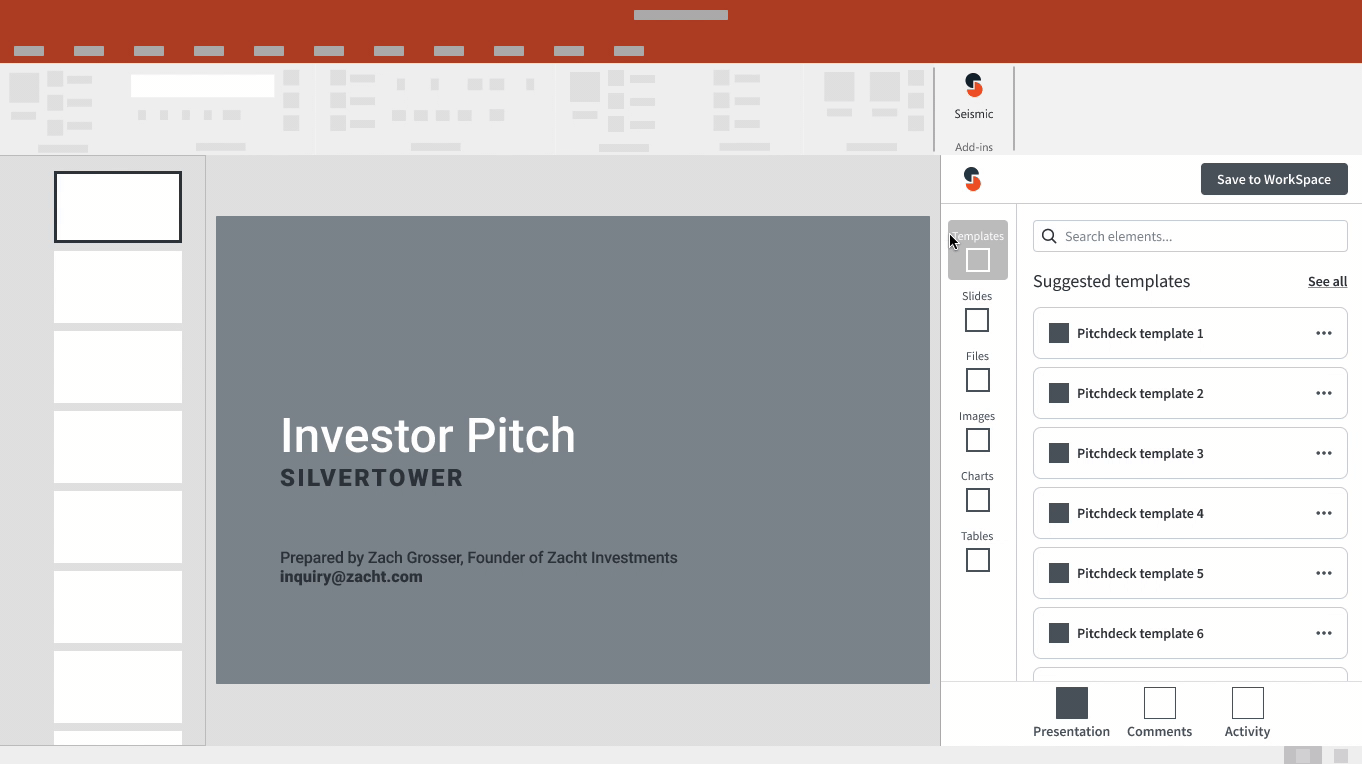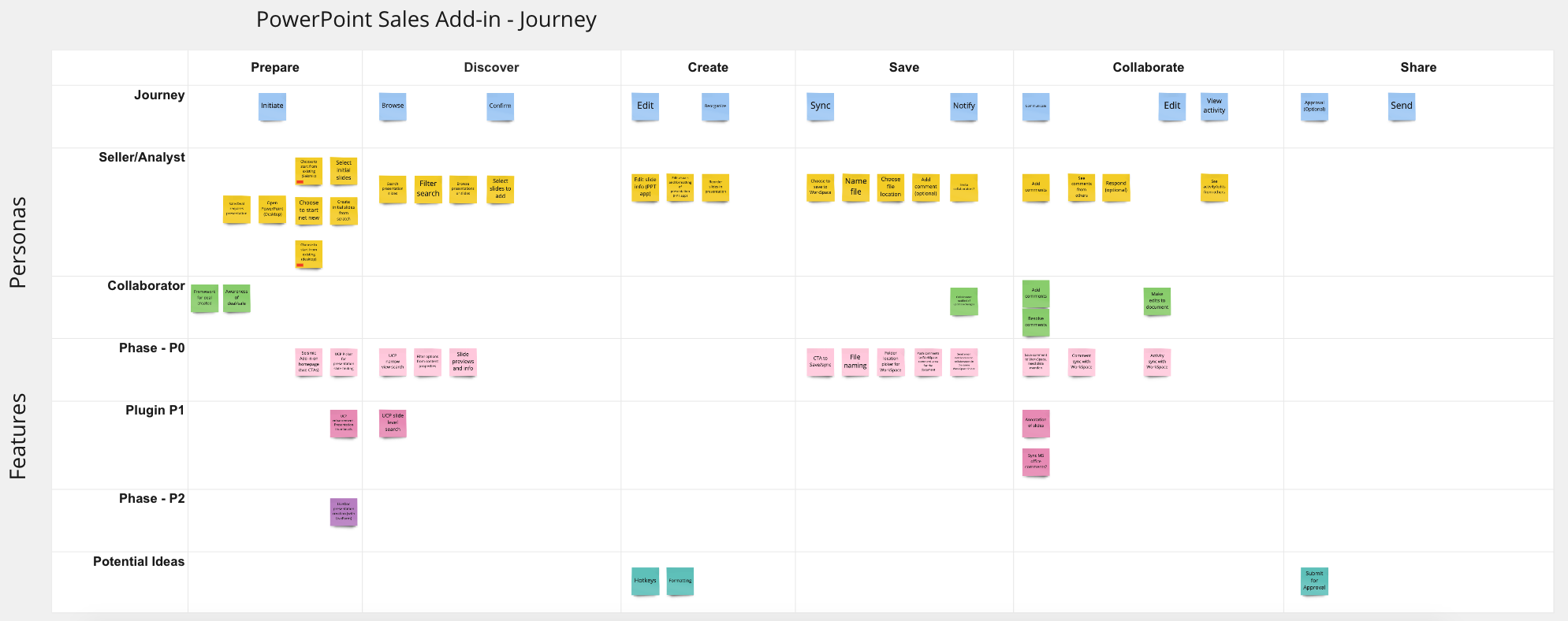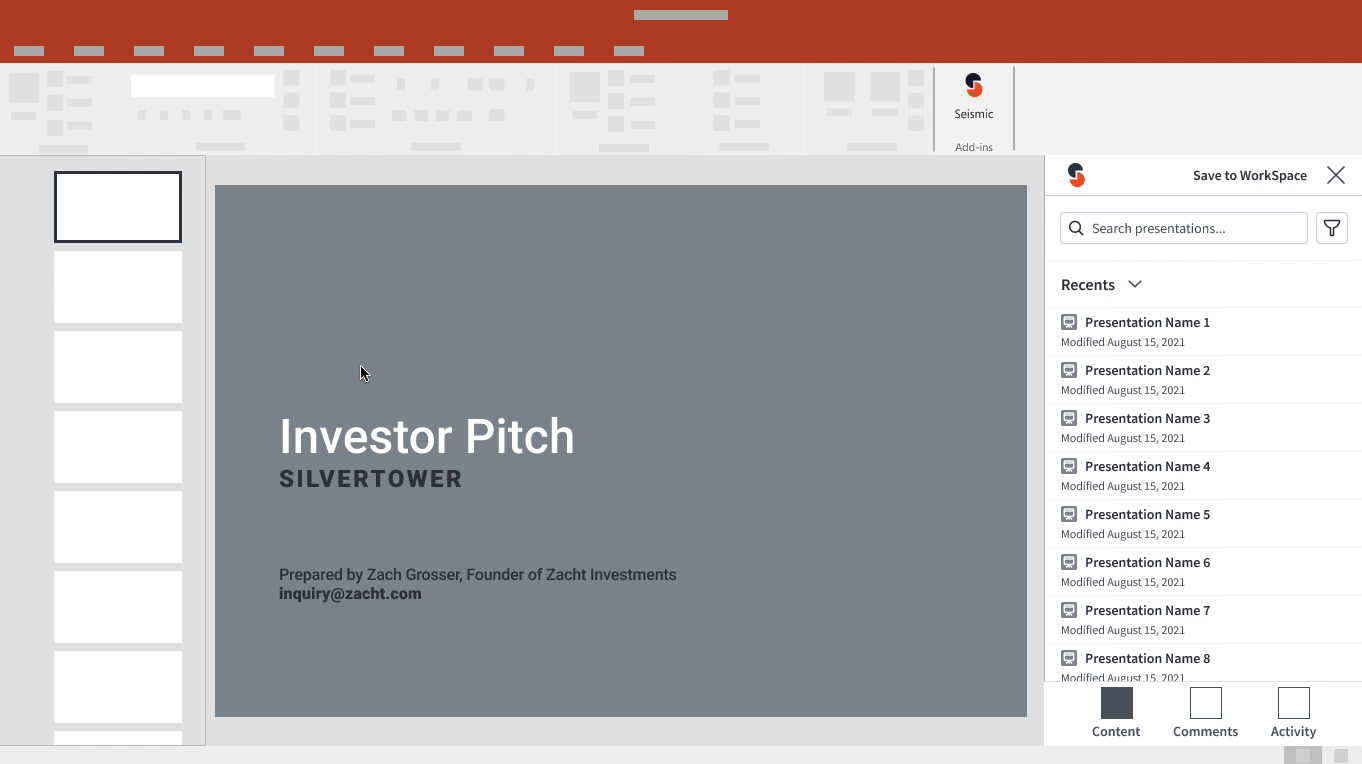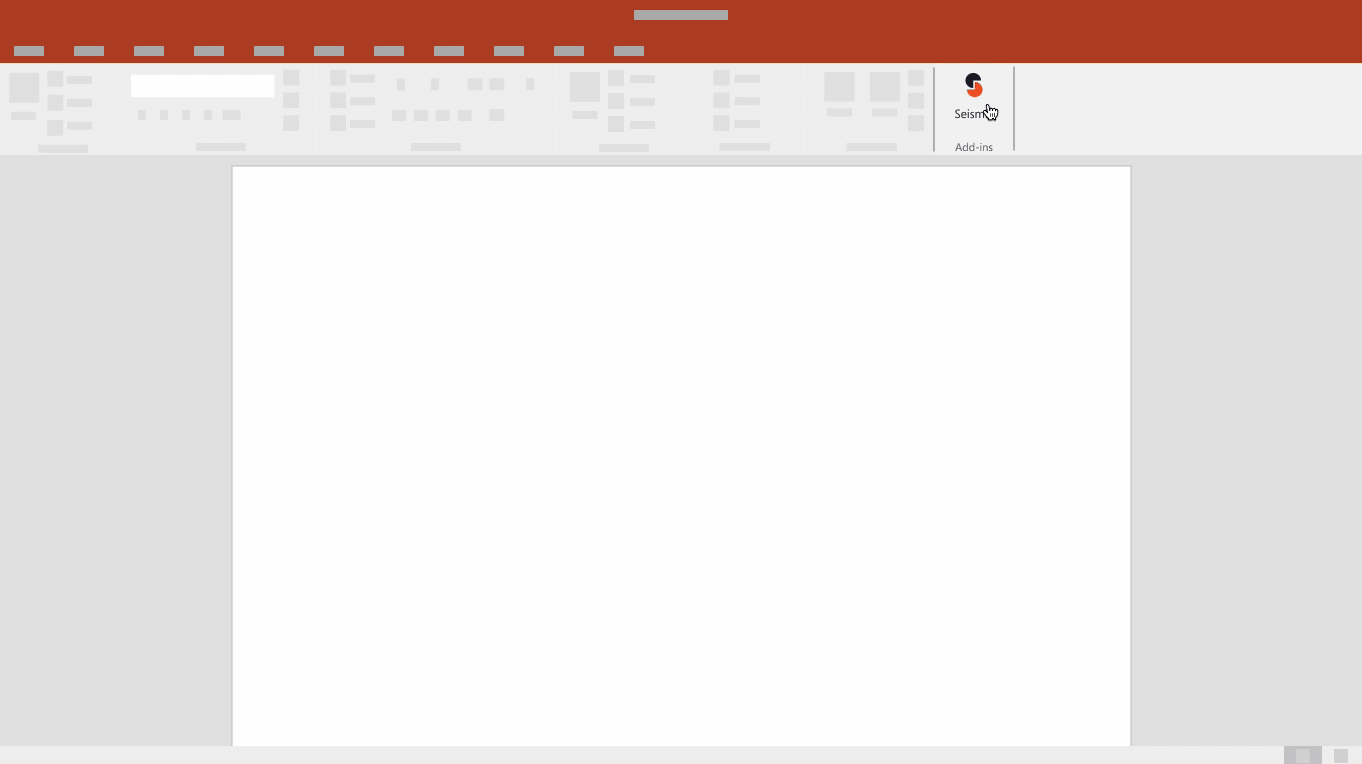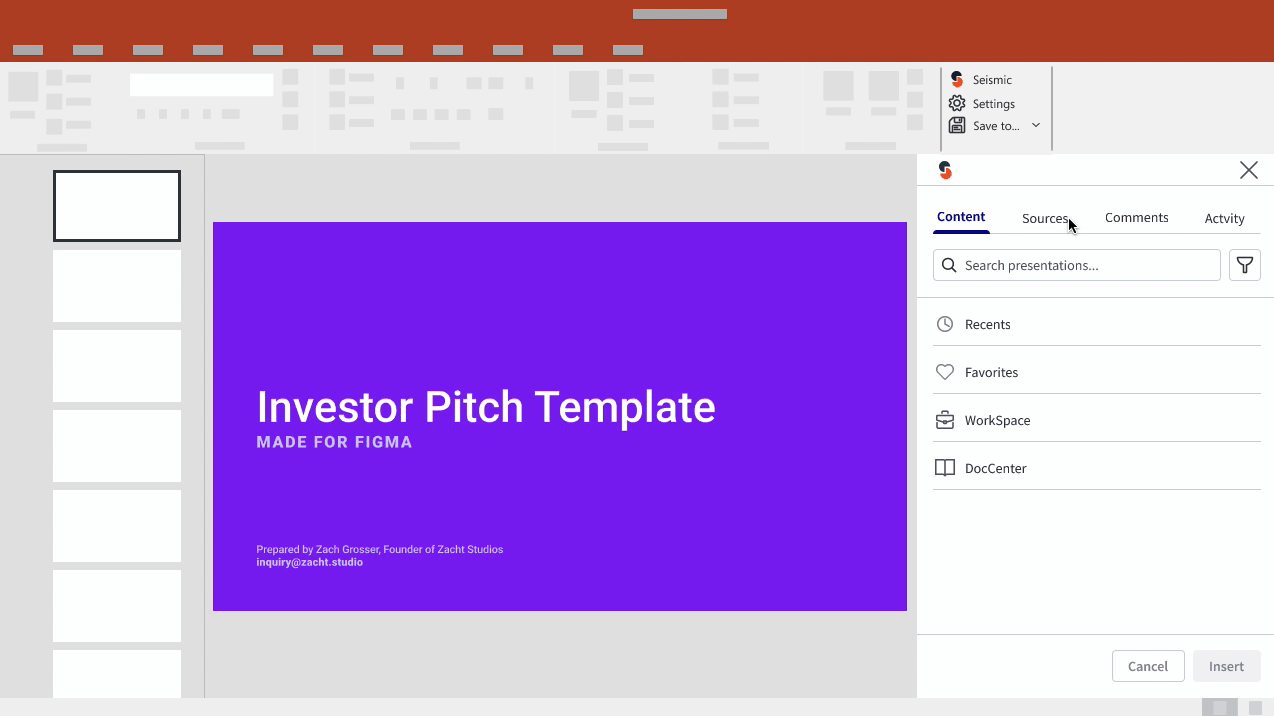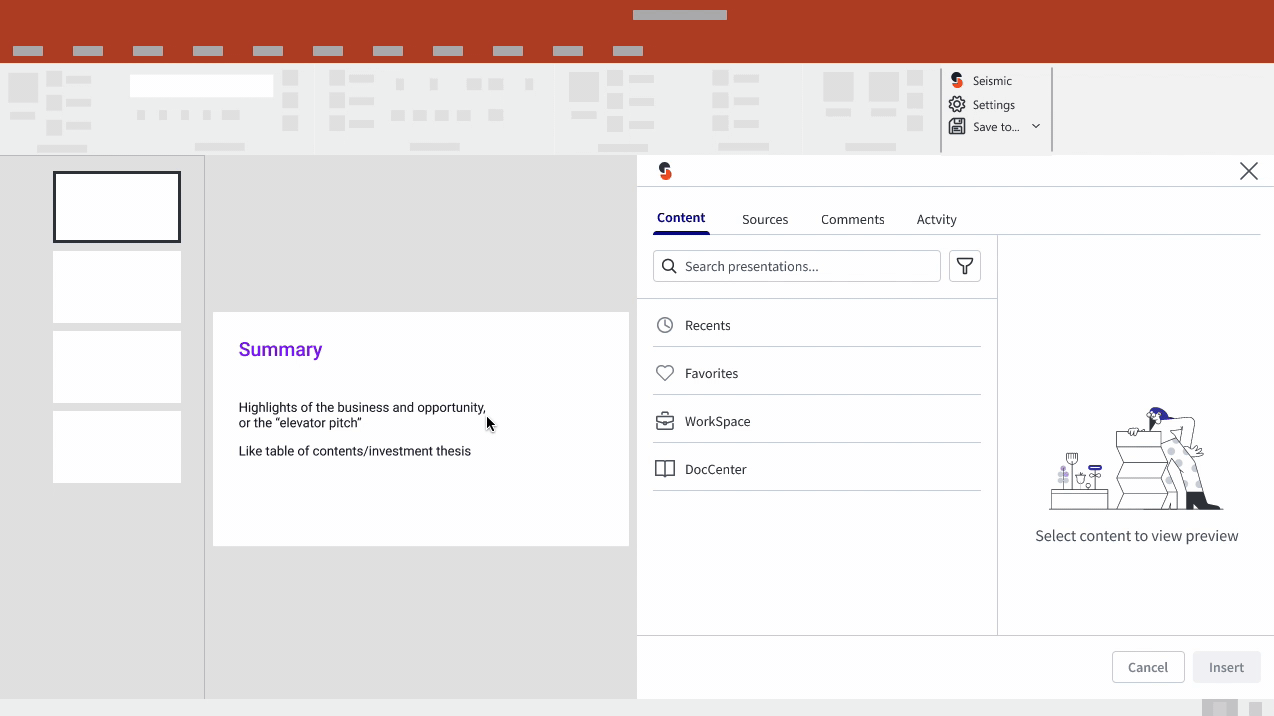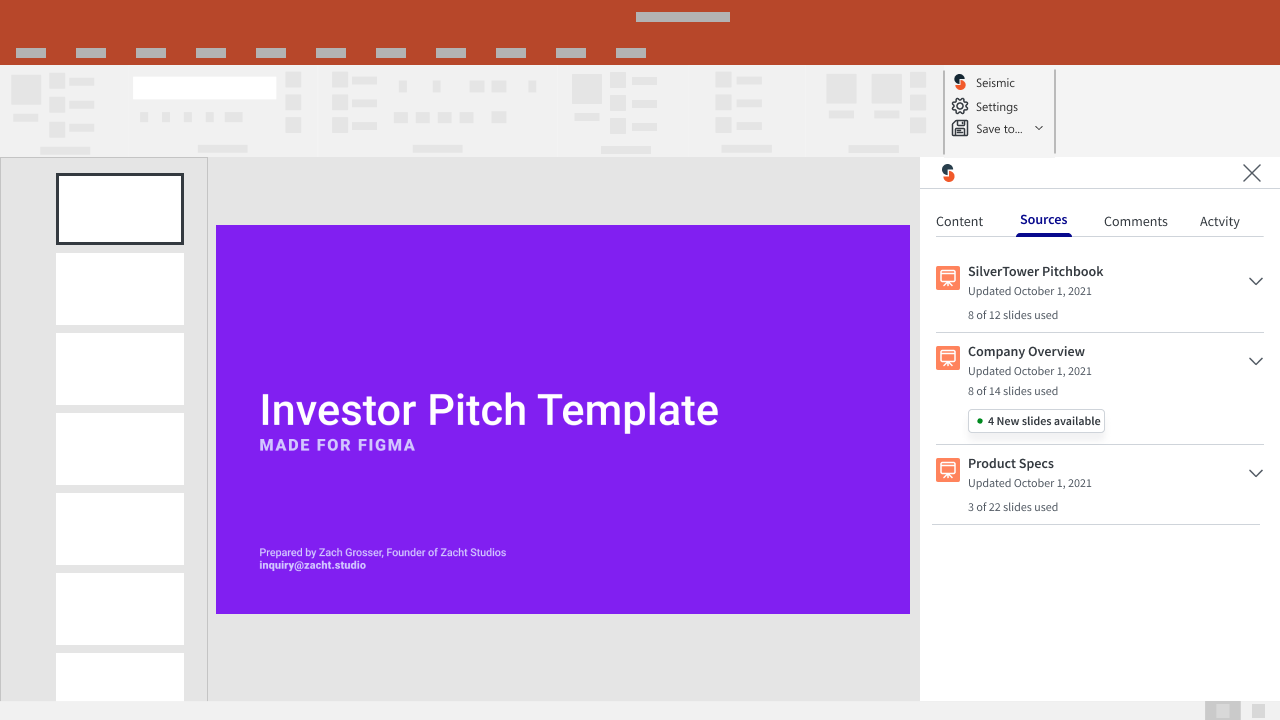Microsoft PowerPoint Add-in
Integrating Seismic into Microsoft PowerPoint, empowering sellers to efficiently create presentations.
Overview
Seismic allows marketing teams to store sales pitch presentations, sellers and analysts customize these presentations for each deal they have. Sellers and analysts need to efficiently assemble presentations to attract more business and close deals faster.marketing teams to store sales pitch presentations, sellers and analysts customize these presentations for each deal they have. Sellers and analysts need to efficiently assemble presentations to attract more business and close deals faster.
Challenge
Financial services analysts and general sellers need help assembling new sales pitches from existing templates or old presentations. They also need a way to collaborate with teammates on the presentations, going through multiple rounds of requests and edits from their managers. Seismic had an existing presentation assembly solution, but it didn’t meet sellers where they work; in PowerPoint.
Constraints
Build an PowerPoint add-in within the Microsoft add-in framework and leverage existing work from other Seismic product teams.
Outcome
A Microsoft add-in that leverages content in Seismic’s library and allows sellers to pull slides from existing presentations, stay up-to-date on slide updates pushed by marketers. The add-in encourages collaboration through comments, annotations, and revision history.
Role
UX copy, UX research, UX design
Time
4 months
Team
1 Product designer
1 Product manager
1 Development team
Product Requirements
Make an interface allowing sellers to search and insert content from their Seismic content library
Allow sellers to sync their working presentation to Seismic, sharing the presentation with their team
Enable sellers to view comments from managers and peers and resolve them as they make edits to their presentation
Create a revision history for tracking by managers
Getting Executive Buy-in
Given the requirements, I created a few wireframes outlining our proposed idea that would allow sellers to assemble presentations using smaller components (charts, tables, logos, images, etc). The Seismic executive team critiqued our idea and encouraged us to allow sellers to assemble presentations using a slide library instead of a component library. Using a slide library instead of a component library would better match Seismic’s backend architecture and result in less work for our development team.
Research
Methods
Moderated discovery interviews
People
Sales representatives and financial analysts: The content creators of the sales presentations that receive instructions on what to create from sales enablers and managers.
Sales enablers and managers: Managing the deal teams, creating instructions for the presentation creation, and “red lining” the presentations (requesting edits).
Findings
Sellers know what slides they are looking for in their content library, they just need to find the presentation that contains those slides
Sales enablers and managers like to give guidance on how much slides can be customized
Sellers/analysts are creating unique presentations for every deal they have
Sellers/analysts often start creating their presentation from an old existing deck or a template provided by their marketing team
Most of the time, sellers/analysts are creating presentations in PowerPoint for desktop and not using existing Seismic presentation assembly solutions
Deal teams typically consist of 4-6 team members
There is lots of collaboration and iterations amongst deal teams, before it can be approved and shown to the client
Sales pitch presentations take a few weeks to create and typically have 25-75 slides on average
Definition
Job-to-be-Done
When I have an upcoming client meeting, I need to efficiently build a customized presentation with my team so that I can close the deal.
Journey Mapping
Once my discovery research was finished, I started mapping out the journey of the users. I created this diagram that outlined themes throughout the journey (top headers). Within each journey theme, I defined sub themes and actions that each persona (Seller/Analyst and Collaborators) would take to create a presentation. The product managers helped to define needed functionality based on the requirements and I helped to determine which phase the development team would build this functionality.
User Flows
To understand what steps were required for a seller/analyst to start, edit, and save a presentation; I defined two main flows:
When a user is creating a brand new presentation
When a user is revising an existing presentation
Both of these flows covered the bases when a sales/analysts gets a new request to build a presentation for a deal and when a sales/analyst is required to make edits to the presentation they originally created. Using color coding, I determined how the flow would begin (teal), what functionality would be native to PowerPoint (orange), and what functionality the add-in would need to account for (yellow).
Concepts
After getting executive buy-in for the project and doing a bit of research, I began creating lo-fidelity wireframes. After each wireframe flow was finished, I would create a prototype and get feedback from my product managers, our development team, and customers.
First Concept
The first concept kept the tabs on the bottom for navigation within the plugin and allowed the user to see slides from a specific presentation. The main action “Save to WorkSpace” was positioned at the top for easy access no matter what tab the user is on.
Key Points
Content tab focused as the first one because usage will be high
Commenting behaviors match an existing pattern in Seismic
Tradeoffs
Tab format at the bottom does not match existing tab patterns within Seismic
CTAs cannot exist in the Microsoft Add-in header
Can only see one slide at a time in a larger view
Second Concept
Going into creating the second concept, I ditched the tab navigation on the bottom in favor of a tab navigation that would be more familiar to existing users of Seismic. Due to tech restraints of Microsoft Add-in technology, I was required to move all CTAs out of the header space. With this concept, I tested out slide only search, which would allow users to search for keywords at the slide level instead if the presentation level.
Key Points
Tab navigation matches that of existing patterns in Seismic
Allows the user to search keywords at the presentation level and at the slide level
“Save to WorkSpace” CTA is prioritized
Users can see multiple slides of a presentation in a larger view
Tradeoffs
Doesn’t have a clear path to enable the user to start from an existing slide presentation
Right panel is starting to become cluttered with too many CTAs, navigation items, and content
Reframe Goals
After presenting the concepts to my team, I decided to make some goals for myself to follow when designing the final experience for the PowerPoint extension.
Onboarding
Create an onboarding experience to help users get started with presentation creation.
Login
Allow users to login to their Seismic account within the add-in.
Commenting
Enhance the commenting feature to allow users to see annotations and resolve old comments.
Quick Workflows
Give users an easy way to start their presentation assembly, from scratch or from existing.
Responsiveness
Make a responsive view for users that want to resize their add-in task pane.
Familiar UX
Match existing UX patterns in the main Seismic application, to create a unified experience.
Finalized Designs
Onboarding
I created onboarding screens so the user could get a jist of how the add-in could help them with their presentation assembly. I wanted to delight the user with use of illustrations, but make the illustrations meaningful at the same time.
Onboarding 1
Onboarding 2
Onboarding 3
Onboarding 4
Login
I included login flows for both our customers that use direct login (as shown) and single sign-on through third party authentication services. I instructed the developers to remember the user’s login by default, so they don’t have to login to Seismic every time they come to the PowerPoint application.
Commenting
Our design system team at Seismic created a new UI for commenting within the platform. I chose to adopt this UI, even though it deviates from the existing commenting patterns. With this new UI, there was no pattern built to let the user know of new comments. I worked on patterns to notify the user and came up with a few ideas:
Number indicator on the commenting tab item
“New” tag for fresh comments that have been left
Toggle for resolving comments that may be irrelevant to the user
Search
Within the add-in, I wanted to allow users to search for specific content, view the results, preview the slides of a presentation, and insert them as the next slide in their working deck.
This design leverages existing content picking technology and the previews ensure that the users know which slides they are inserting.
In the next section, I show how I made the content tab responsive based on the width of the user’s task pane.
Responsiveness
The PowerPoint add-in allows users to resize their task pane and even put it in a new window. I made breakpoints for the slide selector feature of the content tab, so the user could easily see and make the slide previews larger.
The “Activity” tab shows the file’s history of comments and revisions. Allowing deal teams to collaborate effectively on presentations and giving visibility of the presentation assembly process to managers.
Sources and Activity
The “Sources” tab shows the user a list of presentations from the content library that make up the working presentation. It will also show the user of updates to the presentation in the content library.
Full Demo
In this video I explain what happens after the user installs the Seismic PowerPoint Add-in and how they might use it to start creating a presentation deck, find slides from their content library, and save it to their team WorkSpace.
What’s next?
I have worked with developers to get my designs implemented, this has been released to all of our customers as an upgrade option. We will continue to do work on the following:
Get feedback from customers using the product
Implement new asset types to insert into a presentation
Allow users to start from a presentation template
Enable users to search at the slide level, instead of just at the presentation level



